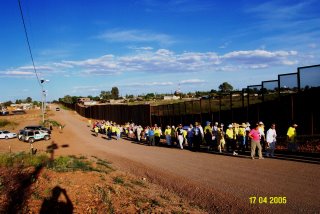The Divine Foundation of the interrelated Body.
What is the foundation that creates, supports, and drives an interrelational idea of church? I believe that a further explanation of a statement I made in the opening post will help guide such a conversation. I wrote, “So therefore, the Foundation on which we stand as an interrelated body, Christ Jesus, must be represented in a faithful way, a way that is faithful to His revelation of Himself.” It is assumed by all of Christianity that Christ Jesus is the Rock on which we stand. Yet, He is not only the foundation on which we stand, He is the image which we are to bear. This image bearing aspect assumes a particular makeup or structural representation. If this structure, the makeup of the Body, is to rightly represent Christ, it is important to at least have a general understanding of the relational quality of our Christ within the Trinity. To present this from the Biblical text I will focus first on various passages from John’s Gospel.
John 1:1-2 “In the beginning was the Word, and the Word was with God, and the Word was God. He was in the beginning with God.” (NASB)
This verse forms the foundation of John’s Gospel as it should serve as the foundation of our understanding of the church. Christ’s personhood within the Trinity must serve as the basis for every tenet of our Faith.
John 1:14, 17-18“And the Word became flesh, and dwelt among us, and we beheld His glory, glory as of the only begotten from the Father, full of grace and truth… For the Law was given through Moses; grace and truth were realized through Jesus Christ. No one has seen God at any time; the only begotten God who is in the bosom of the Father, He has explained Him.”
These scriptures bear at least two important tenets for our discussion. First, the Word (Christ Jesus) became one of us in order to explain the Godhead. The Father used the Word’s incarnation as the method of revealing Himself, Himself as three persons that make up One God. In John 14:9-10 Jesus states; “He who has seen Me has seen the Father; how do you say, ‘Show us the Father’? Do you not believe that I am in the Father, and the Father is in Me?” He showed us, in Christ, that there is interrelation within the Trinity that cooperates in all things for the sake of the will of the Father.
Secondly, within these three verses are two references to the cooperative characteristics of grace and truth. We will speak more of these later in our discussions but let it suffice now to suggest that “grace” and “truth” serve as the scriptural basis for the qualities of “openness” and “limit” within an interrelational understanding of the Body of Christ. If Christ is full of “grace” and “truth” (in order that He might explain the Father), and we are to represent Him properly, then we must also be characterized by both. Jesus’ words in John 5:30 further explain this quality; “I can do nothing on My own initiative. As I hear, I judge; and My judgment is just, because I do not seek My own will, but the will of Him who sent Me.”
The Father and Son are interrelated to an extent that is impossible for us to fully define and in such a way that we are inherently incapable of reproducing. But, we can represent the image of this relation by serving as an interrelated body. John reports Jesus as proposing this very concept on several occasions.
John 10:30 “I and the Father are one.”
John 17:11 “I am no longer in the world; and yet they themselves are in the world, and I come to You Holy Father, keep them in Your name, the name which You have given Me, that they may be one even as We are.”
John 17:22-23 “The glory which You have given Me I have given to them, that they may be one, just as We are one; I in them and You in Me, that they may be perfected in unity, so that the world may know that You sent Me, and loved them, even as You have loved Me.”
We observe, even from these few passages, that Christ desires for us to live in unity not just for the sake of a peaceful existence among Christians but more importantly so that we might represent the relationship that the Son has with the Father. Although I do not agree with every bit of Stanley Grenz’ ethics, he still does a wonderful job in reminding readers that God has revealed Himself to us as a Holy Trinity and wants us to worship and reflect Him as such (See The Social God and Relational Self). Our view of the Body, and thus of the Church, should begin with our understanding of the Head of the Body, Christ Jesus, and the characteristics of His relationship with the Father and Spirit. Give me your thoughts on how viewing such a relationship as the foundation of our ecclesiastical structures might change the way we formulate our local congregations.






